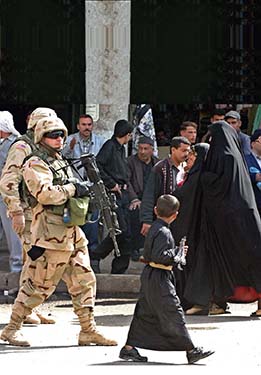American Issues  Connector: America Goes to War
Connector: America Goes to War

U.S. soldiers patrol the streets in Baghdad, Iraq.
TRACK THE ISSUE
![]() When should America go to war?
When should America go to war?
Over the years, the United States has had many motives for going to war. The nation has gone to war to protect itself, gain economic benefits, aid its allies, expand its borders, or increase its power and influence. Under what circumstances is war justified? Americans debate this issue each time the country fights. Use the timeline below to explore this enduring issue.
-
1812 War of 1812
Americans fight to stop Britain from seizing American ships and sailors.
-
1860s Civil War
North and South fight over slavery, states’ rights, and preservation of the Union.
-
1917–1918 World War I
United States goes to war after Germany violates American neutrality.
-
1940s World War II
The Japanese attack on Pearl Harbor draws America into the conflict.
-
1960s–1970s Vietnam War
United States fights to halt spread of communism in Southeast Asia.

A newspaper announces America’s entry into World War I on April 6, 1917.
DEBATE THE ISSUE
War on Terrorism After the terrorist attacks of 2001, the United States invaded Afghanistan and Iraq as part of the War on Terrorism. The war aimed to track down the perpetrators of the terrorist attacks and to prevent future attacks by promoting democracy in the Middle East.
“The use of military force against terrorist networks and regimes abetting their crimes is certainly justifiable…. Our leaders are, in my judgment, morally obligated to use as much force as necessary … to protect innocent Americans and other potential victims of terrorism.”
—Robert P. George, professor, Princeton University
“When you make the argument that there is a ‘just war,’ what you are saying is that there is an aggression, a major offense is being committed and you do not have any other way to protect people from that aggression except to use force.”
—Reverend J. Brian Hehir, Catholic theologian
 TRANSFER Activities
TRANSFER Activities
- Compare Why does Professor George support the War on Terrorism? Why does Reverend Hehir oppose it?
- Analyze Do you think Hehir would have supported the decision to enter World War I? Explain.
- Transfer Use the following Web site to see a video, try a WebQuest, and write in your journal. Web Code: neh-7902




